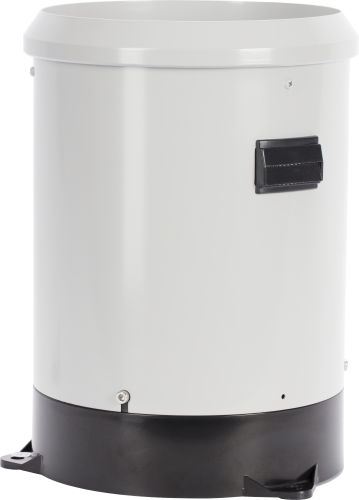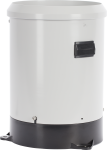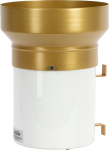
概览
TB4MM 高端翻斗式雨量计,采用公制单位,20.3-cm 集雨口,可测量0.2-mm的降雨增量。TB4MM特别适合高强度降雨的地区或站点使用。兼容Campbell Scientific 所有的数据采集器,广泛应用于环境监测、水文等领域。
优势与特点
- 更精确的测量高强度的降雨
- 高精密度 — 0.2-毫米 刻度增量
- 兼容所有的Campbell Scientific数据采集器 。
- 兼容CWS900系列接口,可用于无线的传感器网络中
图像

技术说明
The TB4MM funnels precipitation into a bucket mechanism that tips when filled to its calibrated level. Each tip is marked by a dual reed switch closure that is recorded by a datalogger pulse count channel. After measurement, the water drains through two orifices (accepts 12 mm tubing) in the base, allowing the measured water to be collected in a separate container.
The TB4MM contains an internal siphon mechanism that causes rain to flow at a steady rate to the tipping bucket mechanism (regardless of intensity). The siphon allows the sensor to make accurate measurements over a range of 0 to 50 cm per hour.
产品规格
| Sensor Type | Tipping bucket with siphon and dual reed switch |
| Rainfall per Tip | 0.2 mm (0.008 in.) |
| Measurement Range | 0 to 700 mm/h (0 to 27.6 in./h) |
| Measurement Uncertainty |
|
| Measurement Uncertainty | 700 mm/h (27.6 in./h) maximum rate per hour |
| Operating Temperature Range | 0° to 70°C |
| Humidity Range | 0 to 100% |
| Cable Type | Two-conductor shielded |
| Drain Tube Size | Both filters accept 12 mm (0.47 in.) ID tubing. |
| Orifice Diameter | 20 cm (7.9 in.) |
| Height | 33 cm (13 in.) |
| Weight | 2 kg (4.4 lb) with 7.62 m (25 ft) signal cable |
兼容性
Please note: The following shows notable compatibility information. It is not a comprehensive list of all compatible products.
数据采集器
| Product | Compatible | Note |
|---|---|---|
| CR1000X (retired) | ||
| CR3000 (retired) | ||
| CR310 | ||
| CR350 | ||
| CR6 | ||
| CR800 (retired) | ||
| CR850 (retired) |
Additional Compatibility Information
Mounting
The base of the gage is supported by three legs. A CM240 Leveling Base and Mount or a user-supplied baseplate with leveling capability is recommended. The CM240 may be attached to a CM300-series mounting pole, or to a user-supplied 1.5 IPS (1.9-inch outer diameter, unthreaded) pipe (see Ordering Information). A concrete pad is recommended.
Wind Screen
Campbell Scientific offers the 260-953 Wind Screen to help minimize the affect of wind on the rain measurements. This wind screen consists of 32 leaves that hang freely and swing as the wind moves past them.
Datalogger Considerations
Compatible Contemporary Dataloggers
| CR200(X) Series | CR800/ CR850 |
CR1000 | CR3000 | CR9000X | CR6 Series | CR300 Series | CR1000X |
 |
 |
 |
 |
 |
 |
 |
 |
Compatible Retired Dataloggers
| CR500 | CR510 | CR10 | CR10X | 21X | CR23X | CR9000 | CR5000 | CR7X |
 |
 |
 |
 |
 |
 |
 |
 |
 |
相关技术文档
常见问题解答
TB4MM-L: 8
展开全部收起全部
-
The following are some suggestions to try:
- Check that there is a solid connection to the reed switch. The screws should be tight, and the wires should have a solid connection to the screws.
- Try switching the connection from the current reed switch being used to the secondary reed switch connection.
- Check that the cable is connected to the correct input on the data logger. Take the two wires on the other end of the cable (the sensor side) and touch them together. The data logger should register a tip. If the tip registers, the issue is with the reed switch. Replace the reed switch.
- If the data logger still doesn't register a tip, try using a different cable.
-
Not registering any tips, missing tips, or double tips.
-
If data is not being logged correctly, there are two likely causes:
- The reed switch has failed.
- There is a faulty connection from the rain gage to the data logger, typically caused by a broken conductor or corroded wiring.
-
- Remove the housing assembly from the base by removing the three screws and lifting upward on the housing.
- Check the bubble level to verify the rain gage is level.
- Pour water through the inner funnel to wet the two bucket surfaces. Using a graduated cylinder, slowly pour 314 cc (19.16 in3) of water, over a 15 minute period, into the collection funnel. This volume of water is equal to 0.39 inches of rainfall (10 mm).
- After the water has passed through the rain gage, the tipping bucket should have tipped 39 times for the TB4-L or CS700-L, or 50 times for the TB4MM-L.
- If the rain gage fails to record the correct number of tips, return the unit to Campbell Scientific for recalibration.
-
Not enough tips or too many tips.
-
The most common errors are either that the rain gage appears to have drifted out of calibration or that the tips are not being correctly recorded by the data logger.
-
When a rain gage is out of calibration, it is usually because of the buildup of dirt and grime on the internal surfaces of the tipping bucket mechanism. Cleaning the internal surfaces usually brings the rain gage back into calibration. It is also possible that a rain gage is out of calibration because it is no longer level.
To minimize the possible occurrence of calibration errors, perform routine cleaning and maintenance of the rain gage at least once every three months. The environmental conditions at a particular site may require a facility to perform cleaning, leveling, and maintenance on a much more frequent schedule.
-
The 260-953 Alter-type rain gage wind screen consists of 32 heavy metal leaves that hang freely and swing as the wind moves past them. The swinging leaves act as a wind damper and help minimize the effect of wind on the rain measurements without adding additional turbulence.





